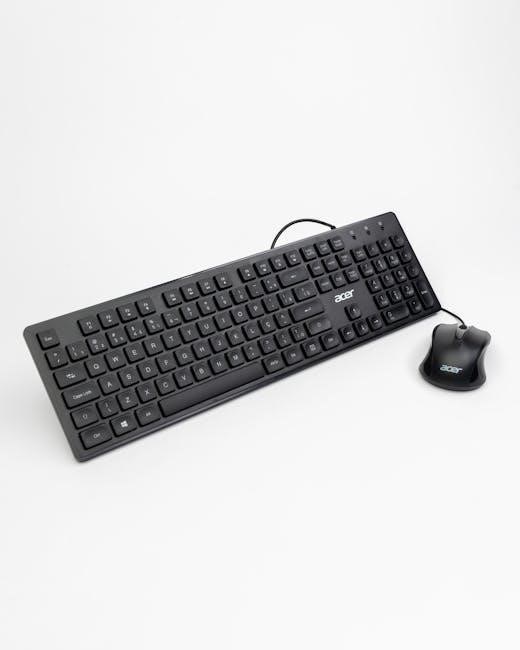Welcome to the Honeywell Alarm Keypad User Manual. This guide provides essential information for installing‚ operating‚ and maintaining your Honeywell security system. It covers key features‚ safety precautions‚ and troubleshooting tips to ensure optimal performance.

1.1 Purpose of the Manual
This manual is designed to provide users with a comprehensive understanding of the Honeywell Alarm Keypad system. It covers installation‚ operation‚ and troubleshooting‚ ensuring safe and effective use. The guide is intended for both new and experienced users‚ offering detailed instructions to maximize system functionality. By following this manual‚ users can navigate features‚ customize settings‚ and resolve common issues efficiently. It serves as a reference for understanding the keypad’s capabilities‚ ensuring optimal security and convenience. The manual is structured to be user-friendly‚ with clear explanations and step-by-step guidance for every aspect of the system.
1.2 Safety Precautions
To ensure safe and effective use of the Honeywell Alarm Keypad‚ follow these precautions. Avoid touching electrical components without proper grounding to prevent shock. Keep the keypad away from water or moisture to avoid damage. Do not modify or tamper with the system‚ as this may void the warranty or compromise security. Use only authorized replacement parts and batteries to maintain functionality. Regularly inspect the system for wear or damage and address issues promptly. Always follow the manufacturer’s instructions for installation and maintenance. By adhering to these guidelines‚ you can ensure the system operates reliably and safely‚ protecting your property and loved ones effectively.

Installation and Setup Guide
This section provides a step-by-step guide for installing and setting up your Honeywell Alarm Keypad. Ensure the system is powered correctly and all components are connected properly. Follow the manufacturer’s instructions for mounting and wiring to avoid damage or malfunction. After installation‚ test the keypad to confirm functionality and connectivity. Proper setup ensures reliable performance and optimal security for your home or business.
2.1 System Requirements
The Honeywell Alarm Keypad is compatible with various Honeywell security systems‚ including the VISTA series control panels. Ensure your system supports wireless or wired connectivity‚ depending on the keypad model. The 6150RF and 6160RF keypads require a compatible receiver or transceiver module for proper communication. A stable power supply‚ typically 12V DC‚ is essential for operation. For advanced features like voice control‚ ensure the system firmware is up-to-date. The keypad must be installed in a location with optimal signal strength to avoid interference. Always verify compatibility with your specific control panel and wireless devices before installation. Proper system requirements ensure seamless functionality and reliable security performance.
2.2 Physical Installation Steps
Begin by selecting a suitable location for the Honeywell Alarm Keypad‚ ensuring easy access and visibility. Mount the keypad on a wall or place it on a flat surface‚ following the manufacturer’s guidelines. Connect the keypad to the control panel using the appropriate wiring or wireless receiver‚ depending on the model. For wired models‚ carefully strip and connect the wires to the designated terminals. Secure the keypad to the mounting plate using screws provided. Ensure all connections are tight and insulated to avoid interference. Power up the system and test the keypad to confirm functionality. Refer to the control panel manual for specific wiring diagrams and compatibility instructions. Proper installation ensures reliable performance and system integration.
2.3 Initializing the Keypad
After physical installation‚ power on the keypad and allow it to boot up. Enter the default master code (typically 1234) to access the system. The keypad will display a ready state‚ indicating successful initialization. Familiarize yourself with the keypad layout‚ including function keys and zone indicators. Test each key to ensure proper functionality. If voice control is enabled‚ check the volume and clarity of voice prompts. Verify that all zones are recognized and properly labeled. Consult the manual for specific initialization steps tailored to your system configuration. Ensure all features‚ such as chime mode and bypass options‚ are operational. This step ensures the keypad is fully integrated with your security system and ready for use.

Basic Operations
Mastering basic operations ensures smooth interaction with your Honeywell alarm system. Learn to arm‚ disarm‚ and navigate the keypad intuitively for enhanced security control.
3.1 Understanding the Keypad Layout
The Honeywell alarm keypad is designed for intuitive operation‚ featuring a user-friendly layout with backlit keys for easy navigation. The keypad includes a numeric display for zone identification and system prompts. Function keys are programmable for specific actions‚ such as arming or disarming the system. LED indicators provide visual feedback‚ showing system status like “Ready‚” “Armed‚” or “Alarm.” The keys are organized into logical groups‚ with dedicated buttons for functions like “Away‚” “Stay‚” and “Chime.” Understanding the layout ensures efficient use of the system. Refer to the diagram in this manual for a visual guide to the keypad’s features and controls; Proper familiarity with the layout enhances security management.
3.2 Arming and Disarming the System
Arming and disarming your Honeywell security system is a straightforward process. To arm the system in “Away” mode‚ enter your user code followed by the “Away” button. The system will confirm with a beep and display “Armed Away.” For “Stay” mode‚ enter your code and press “Stay‚” which arms perimeter zones only. Disarming is done by entering your user code and pressing “Off.” The keypad will confirm disarming with a beep and display “Disarmed.” Ensure all zones are secure before arming to avoid false alarms. The “Ready” light will illuminate when the system is ready to arm. Always verify the system status before leaving your premises. Proper arming and disarming ensure your security system functions effectively.
3.3 Basic Functions and Features
The Honeywell Alarm Keypad offers a range of basic functions designed to enhance security and user convenience. The chime mode alerts you when doors or windows are opened‚ providing audible feedback for system activity. Zone bypass allows you to deactivate specific zones temporarily without disarming the entire system. Function keys can be programmed for quick access to frequently used commands‚ such as arming‚ disarming‚ or activating panic alarms. The keypad also features a backlit display for easy navigation in low-light conditions. These functions ensure intuitive operation and customization to meet your security needs. Regular use of these features will help you maintain a secure and efficient system.
3.4 Bypassing Zones
Bypassing zones on your Honeywell Alarm Keypad allows you to temporarily deactivate specific zones without disarming the entire system. This feature is useful for granting access to certain areas while maintaining security in others. To bypass a zone‚ enter your user code‚ select the bypass option‚ and choose the zones you wish to deactivate. The system will confirm each bypass with a beep. Bypassed zones remain inactive until you manually un-bypass them or disarm the system. This function ensures flexibility in managing your security setup while maintaining overall system integrity. Regular use of zone bypassing can enhance convenience without compromising safety. Ensure all zones are properly secured when no longer needed.
3.5 Chime Mode
The Chime Mode on your Honeywell Alarm Keypad provides audible alerts for system events‚ such as door openings or zone activity‚ without triggering a full alarm. To enable Chime Mode‚ press the “Chime” button or enter your user code followed by the chime command. The keypad will confirm activation with a tone. In Chime Mode‚ you’ll hear distinct sounds for events like arming‚ disarming‚ or zone breaches. This feature enhances awareness of system activity while avoiding unnecessary alarms. You can adjust the volume or disable Chime Mode by repeating the activation process. Use this mode to stay informed about daily movements and system status changes.

Advanced Features
Explore advanced features like voice control‚ customizable function keys‚ and enhanced user code management to tailor your Honeywell Alarm Keypad to your security needs.
The Honeywell Alarm Keypad allows you to customize function keys to suit your specific security needs. These keys can be programmed for panic alarms‚ quick arming‚ or bypassing zones. For instance‚ the function keys can be set to trigger instant alerts or activate specific security protocols with a single press. To customize‚ press and hold the desired key for at least 2 seconds until the keypad confirms the selection. Refer to your system installer for detailed programming instructions‚ ensuring your setup aligns with your security preferences. This feature enhances convenience and personalizes your system’s operation. Managing user codes on your Honeywell Alarm Keypad is straightforward and essential for system security. The default master code is typically 1234‚ but it is highly recommended to change it for enhanced security. To add a new user code‚ enter the master code‚ followed by the number 8‚ and then the new code. The keypad will beep to confirm the addition. Similarly‚ deleting a user code involves entering the master code‚ pressing 8‚ and then the code you wish to remove. Ensure all users understand their codes to maintain system integrity. Regularly updating codes and limiting access to the master code are best practices to safeguard your security system. The Honeywell Alarm Keypad offers advanced voice control features‚ enhancing user convenience and system interaction. Voice commands allow you to arm‚ disarm‚ and check the system status hands-free. To activate voice control‚ ensure the feature is enabled in the system settings. Use predefined commands like “Arm Away” or “Disarm” to control the system. The keypad also supports voice prompts for zone identification and system status updates. Volume adjustment is available via dedicated keys‚ ensuring clear audio feedback. For added security‚ voice commands may require a valid user code to execute certain actions. This feature streamlines operation and provides an intuitive user experience. This section helps resolve frequent problems like error codes‚ system resets‚ and communication issues. Consult the manual or contact Honeywell support for detailed solutions. The Honeywell Alarm Keypad may display error codes like “Check 01” or “FC 02 03‚” indicating system faults or communication issues. These codes help identify specific problems‚ such as zone faults‚ low battery levels‚ or loss of connection to the control panel. Refer to the troubleshooting section for detailed explanations of each code. For example‚ “FC 02 03” often relates to wireless device communication errors. To resolve these issues‚ check wiring‚ ensure devices are powered on‚ and verify system settings. If problems persist‚ resetting the system or consulting the manual may be necessary. Always contact Honeywell support for advanced assistance. Regular system checks can prevent recurring errors. Resetting your Honeywell Alarm Keypad is a straightforward process to restore default settings or resolve system glitches. Start by ensuring the system is disarmed. Enter your master code followed by the command “8 0” to initiate a system reset. This will clear all user codes and settings‚ reverting to factory defaults. If issues persist‚ power down the system‚ disconnect the backup battery‚ and wait 30 seconds before reconnecting. Turn the power back on and reprogram your codes and settings. For severe problems‚ contact Honeywell support for advanced reset procedures. Regular resets can help maintain system stability and performance. Always refer to the manual for detailed instructions. If your Honeywell Alarm Keypad experiences communication issues‚ start by ensuring a stable power supply and proper wiring. Check for interference from nearby devices that may disrupt RF signals. Reset the system by entering your master code followed by “8 0” to restore default settings. Verify that all zones are correctly programmed and that the keypad is synced with the control panel. For wireless models‚ ensure the transceiver is functioning and within range. If issues persist‚ reprogram the function keys or update the firmware to the latest version. Refer to the manual for specific instructions on resetting or reconfiguring communication settings. Contact Honeywell support if problems remain unresolved. Regular checks can help maintain seamless system operation.
Regularly update your Honeywell Alarm Keypad’s firmware to ensure optimal performance and security. Clean the keypad to prevent dust buildup and maintain responsiveness. Schedule routine inspections to check for worn-out components. Replace batteries in wireless devices as needed and verify all connections. Perform system tests after updates to confirm functionality. Keep the user manual handy for reference during maintenance tasks. Proper care extends the lifespan and reliability of your Honeywell security system; Firmware updates are essential for maintaining the optimal performance and security of your Honeywell Alarm Keypad. Regular updates ensure that your system operates with the latest features‚ bug fixes‚ and security enhancements. To update the firmware‚ download the latest version from the Honeywell website or through the Honeywell Home app. Connect your keypad to the control panel using a USB cable if required. Follow the on-screen instructions to complete the update process. Ensure the system is powered on and avoid interruptions during the update to prevent potential issues. After the update‚ verify that all functions work correctly. Keeping your firmware up-to-date is crucial for maximizing system reliability and functionality. Always refer to the user manual for detailed instructions specific to your model. Regular maintenance is crucial to ensure the Honeywell Alarm Keypad operates efficiently and reliably. Start by cleaning the keypad with a soft cloth and mild detergent to remove dirt and fingerprints. Avoid harsh chemicals or abrasive materials that could damage the screen or buttons. Check the power supply and ensure all connections are secure. If your keypad uses batteries‚ test them periodically and replace them as needed. Inspect the wiring for any signs of damage or wear‚ and consult a professional if issues are detected. Additionally‚ verify that all zones and sensors are functioning correctly. Proper maintenance will help prevent malfunctions and ensure your security system remains effective. Regular checks also help identify potential issues before they escalate. Keep your system up-to-date and functioning at its best. Adopt strong security habits to protect your Honeywell system. Use complex‚ unique user codes and change them regularly. Regularly review and update authorized users. Ensure all family members and staff are trained on system operations. Keep the keypad out of reach from unauthorized individuals and avoid sharing codes publicly. Monitor system activity and report any suspicious behavior promptly. Perform routine checks to ensure all sensors and zones are functioning properly. Stay informed about potential security threats and update your system as needed. By following these practices‚ you enhance the safety and reliability of your Honeywell security system. Securing user codes is critical to maintaining the integrity of your Honeywell alarm system. Always use strong‚ unique codes and avoid sharing them with unauthorized individuals. The default master code (typically 1234) should be changed immediately upon setup. Regularly update codes to prevent unauthorized access. To add a new user code‚ enter the master code‚ press the “8” key‚ and input the new code. To delete a code‚ follow the same process but select the code to remove. Ensure all users understand the importance of code confidentiality. Never display codes near the keypad or in public areas. By safeguarding user codes‚ you protect your system from potential breaches and ensure maximum security. Regular system checks are essential to ensure your Honeywell alarm system operates efficiently. Perform a weekly test by arming the system‚ triggering a sensor‚ and verifying the alarm sounds. Check the keypad display for any error messages or low battery alerts. Test all zones to confirm they function correctly and adjust any sensors if necessary. Additionally‚ inspect wiring and connections for damage or wear. Schedule annual professional inspections to maintain optimal performance; By conducting these checks‚ you can identify and address issues early‚ ensuring your security system remains reliable and effective. Regular maintenance also extends the lifespan of your equipment. Stay proactive to safeguard your property and loved ones. In case of an alarm‚ stay calm and follow the predefined emergency plan. Evacuate the premises immediately and contact authorities. Use the keypad to silence or verify the alarm status. Always prioritize safety and ensure all occupants are accounted for. Regular drills and familiarization with the system enhance emergency response efficiency. Keep emergency contact numbers accessible and inform all users about proper procedures. When an alarm is triggered‚ remain calm and take immediate action. First‚ ensure all occupants are safe and evacuate the premises if necessary. Check the keypad display to identify the zone causing the alarm. Enter your user code to silence the alarm if it’s a false trigger. If the situation is urgent‚ contact emergency services promptly. Verify the cause of the alarm to prevent future occurrences. After resolving the issue‚ ensure the system is reset and ready for rearm. Always follow the emergency plan established for your location. Regular drills can help improve response times and safety. Keep emergency contact numbers nearby for quick access. To silence an alarm‚ locate the Honeywell keypad and enter your valid user code. Press the “Off” or “1” button to disarm the system. The alarm will stop‚ and the keypad will confirm with a beep. If the alarm persists‚ ensure all zones are secure and retry the process. For false alarms‚ investigate the cause to prevent recurrence. Always verify the system status post-alarm to ensure proper functionality. Regular checks and user training can enhance alarm response efficiency. If issues persist‚ consult the troubleshooting section or contact Honeywell support for assistance. Remember‚ timely action is crucial for maintaining security and system reliability. Mastering your Honeywell Alarm Keypad enhances security and convenience. This manual provided a comprehensive guide to operate‚ troubleshoot‚ and maintain your system effectively. Explore advanced features‚ ensure regular checks‚ and contact Honeywell Support for further assistance. The Honeywell Alarm Keypad offers a range of features designed to enhance security and user convenience. It includes a backlit display for easy navigation‚ voice control options‚ and customizable function keys for tailored operations. The system supports chime mode‚ zone bypassing‚ and advanced arming/disarming functionalities. With robust integration capabilities‚ it works seamlessly with Honeywell security systems‚ ensuring reliable performance. Additional features like firmware updates and routine maintenance options ensure long-term efficiency. The keypad’s intuitive design and user-friendly interface make it accessible for both new and experienced users. These features collectively provide a secure‚ flexible‚ and adaptable solution for home or business security needs. For any questions or issues regarding your Honeywell Alarm Keypad‚ contacting Honeywell Support is straightforward. Visit the official Honeywell website at http://www.security.honeywell.com to access contact information‚ downloadable manuals‚ and troubleshooting guides. You can also reach out to their customer service team via phone or email for personalized assistance. Additionally‚ the Honeywell 6150RF User Guide and other resources are available online for quick reference. For urgent matters‚ such as alarm system malfunctions‚ contact their 24/7 support team at 1-800-FOX-BROS. Ensure to have your system details ready for efficient resolution. Regularly check their support page for updates and FAQs to resolve common issues independently.4.1 Customizing Function Keys
4.2 Managing User Codes
4.3 Voice Control Features

Troubleshooting Common Issues
5.1 Common Error Codes
5.2 Resetting the System
5.3 Resolving Communication Issues

Maintenance and Updates
6.1 Firmware Updates
6.2 Routine Maintenance

Security Best Practices
7.1 Securing User Codes
7.2 Regular System Checks

Emergency Procedures
8.1 Responding to an Alarm
8.2 Silencing the Alarm

9.1 Summary of Key Features
9.2 Contacting Honeywell Support
